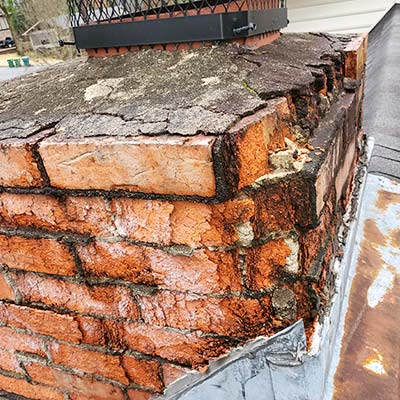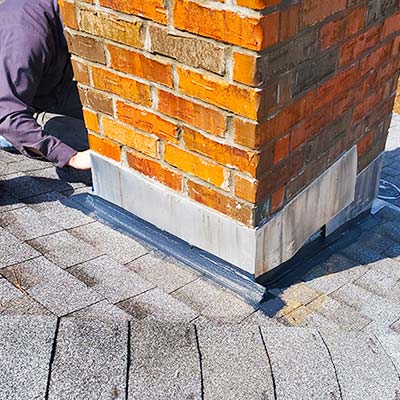Why Chimneys Leak and What Can Be Done to Fix It
Chimney leaks are a much more serious problem than most people realize. The water you see in your fireplace or the stains you see on your roof and ceiling around the chimney are just on the surface. By the time you see evidence of chimney leaks, what you can’t see on the inside is seriously compromised.
There are many reasons why chimneys leak and diagnosing the cause can be difficult for homeowners. Chimney water penetration can occur at multiple points of entry and most of the time there is more than one place the chimney is leaking from. More often than not, homeowners that try to fix chimney leaks find that their chimney is still leaking despite their best efforts.
Regardless of the difficulty in diagnosing and repairing chimney leaks, they are worth the effort to fix. Chimney leaks tend to get worse over time allowing more and more water to enter your chimney and home.
The Cost of Chimney Leaks
Chimney leaks can cause major damage. Long term chimney leaks can corrode the internal working components of your chimney and fireplace like your damper. They can also corrode the masonry of your chimney which can leave gaps between your flue tiles and firebrick. This is a serious fire hazard and many houses burn down every year from leak related chimney masonry problems. Finally, chimney leaks can seriously damage the surrounding structure in your home. Chimney leaks will rot your roof, ceiling and surrounding walls.
The cost of waterproofing your chimney and stopping leaks is much cheaper than allowing the leak to continue without repair. Flue repair and home structural repairs in particular can cost many thousands of dollars to fix.
Three Major Areas Where Chimneys Leak
The Chimney Crown
The crown or, top of the chimney, is your chimney’s first line of defense against the rain. Unfortunately, it is the first thing that rain lands on and usually the first part of the chimney to leak. Even brand new chimney crowns leak. Crowns on masonry chimneys are made from masonry cement. Cement is porous. When rain falls on your crown, it soaks in. Then gravity takes effect and the water seeps downward.
Cheap shortcuts builders take, like small chimney caps that only cover the flue, leave your crown exposed to the weather. Freeze thaw cycles on a wet crown lead to cracks and accelerated water entry.

The Chimney Exterior
Like the crown, the entire surface exterior of a chimney is porous. The chimney bricks and mortar absorb a lot more water than you would think. Each brick can hold 3 cups of water. Multiply that by how many bricks are in your chimney and you already have a good idea why it is so important to waterproof your chimney. And, just like a crown, wet bricks and mortar on your chimney’s exterior crack and degrade in freeze thaw cycles. Left unchecked, chimneys will literally fall apart.
Even new chimneys that aren’t cracked “yet” absorb enough water to damage your home’s structure through seepage. Cracks will develop over time if a chimney isn’t waterproofed.
That’s not soot and creosote that looks so nasty. A telltale sign of leaks in older chimneys is black mold and algae growth and moss growing in the cracks.

The Chimney Flashing
Chimney flashing is another common cause if chimney leaks. Most frequently, flashing leaks are caused by water seepage under the roof shingles beyond the reach of the flashing. Even properly installed flashing can leak due to water seepage. However, defective flashing and mortar degradation where the flashing connects to the chimney are also common culprits.
Leaking chimney flashing can be caused by or be in addition to chimney exterior surface leaks. Sometimes exterior surface leaks can make it seem that the flashing is leaking although the leak is from water seepage from the chimney structure itself under the chimney flashing. This is why it is always a good idea to waterproof the chimney exterior and seal the flashing at the same time to be sure the source or sources of the leak are all covered.

How We Waterproof Chimneys
At A-1 Chimney Pro we follow a three step process to make sure your chimney is completely waterproofed and the leaks are stopped. All three major areas of water entry are addressed.
- Cover the crown with a full cover chimney cap to protect the top of the chimney from the elements
- Waterproof the chimney exterior to stop water absorption through the surface
- Seal the flashing to stop water seepage under the shingles
When all three of the above steps are taken, there is no point of entry left for water to get in. We call this the “Bulletproof Treatment”. We are so confident in this process that we give our clients a 5 year leak free guarantee when the Bulletproof Treatment is used to waterproof their chimney.
